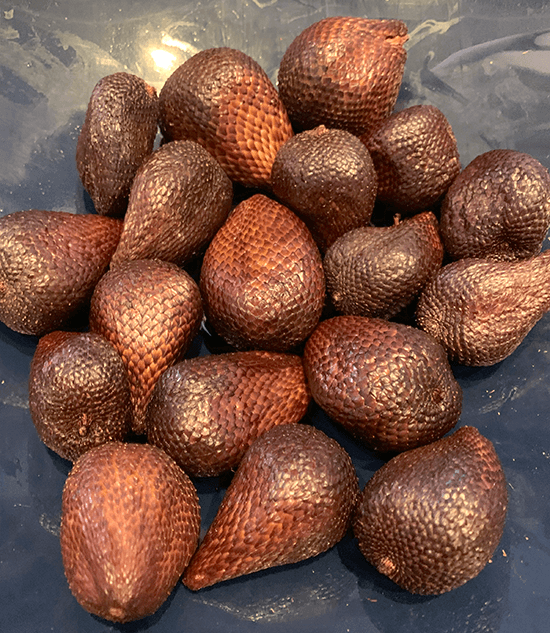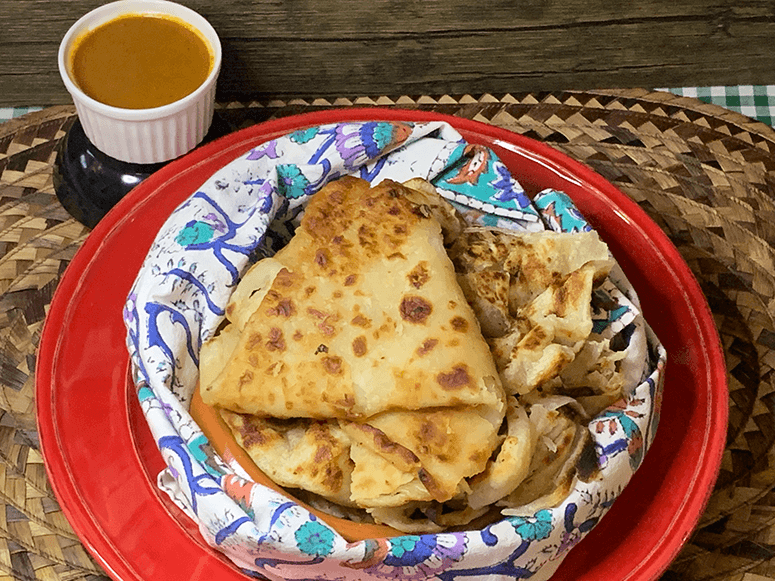The rules of making Roti
Whenever I’m in a Malaysian restaurant, I always order a plate of roti canai. This flat, unleavened bread is said to have originated from India, but the Malaysians have surely made it their own. Fluffy, with wisps of crispy layers, roti is the perfect start to a Malaysian or Singaporean meal, especially when dipped in a pungent curry sauce.
On a recent trip to Kuala Lumpur, I had a chance to watch a real pro make roti while on a walking food tour. It looked easy but, as some of my companions who tried their hand at it found out, making roti can be quite tricky. It takes practice to perfect the moves, which include swirling the dough in midair, then slapping it on an oiled surface and flattening it to a transparent thinness.
We were soon served some of the restaurant’s freshly cooked, warm roti, which we delightedly dipped in the curry sauce, but as our guide Siddoz soon warned us, we had to keep moving as we had about 12 more dishes to try.
Earlier, we had started our tour with a taste of assorted Malaysian fruits, some of them familiar, some strange and new. Among the latter was snake fruit, which had a rough, scaly outer covering (hence the name), and a sweet, sour, slightly bitter yellow fruit.

Our guide also taught us how to choose mangosteen: you press the fruit near the top, and if it’s slightly soft, then it’s ripe and sweet.
If Taiwan has its stinky tofu, Malaysia has its stinky beans. Passing by a vegetable stall, Siddoz pointed out that those long beans were not in themselves stinky, but the effect it had on the eater was. My companions said it tasted somewhat like kamachile.
What wasn’t stinky, to me at least, was the durian. I’ve always loved this fruit, to which many are averse because of its strong aroma. That evening, Siddoz brought us the musangking variety of durian, which is said to be one of the best. It was sweet, creamy, and smooth as custard. Since the hotel where we were staying doesn’t allow guests to bring in durian, I took the opportunity to have my fill of this exotic fruit.
As we continued walking along Kuala Lumpur’s wet markets, we stopped here and there for more food tastings. Siddoz made sure we tried curry laksa, one of Malaysia’s most beloved dishes. Made with chicken stock, the colorful soup was lavished with fragrant spices, plus ginger flowers to tame the heat. Handmade wheat noodles, bean sprouts, and clams were among the ingredients floating in the lush, vibrant soup.
A variation of the laksa was the beehon soup, which had yellow rice noodles, beef and a very detectable presence of turmeric. We also tried the asam laksa, a traditional Malay dish spiked with lemongrass, Vietnamese coriander, onion, tamarind peel, chili paste, and shrimp paste.
Walking farther along, we stopped at a restaurant where we had skewers of hot, grilled beef and chicken satay, served over cubes of sticky rice and enlivened with a peanut dip. This was followed by seasoned mackerel that had been charcoal-broiled in banana leaves.
Of course, we had to have nasi lemak, too—rice cooked in pandan leaves and rich, thick coconut milk. With toppings of peanuts, sambal and dried fish, it’s considered Malaysia’s national dish. A cousin of the nasi lemak is the nasi kerabu, a rice with a nutty taste, imbued with a pale blue color by the fresh pea flowers in which it was cooked.
For dessert the unanimous choice was chendol. The iced mixture of sweet coconut milk and assorted fruits was just the perfect palate refresher after all the exotic flavors we had tasted. It also reminded me of our own halo-halo.
We ended the tour at the foot of the famous Petronas Twin Towers. By this time it was past 9 p.m. I was surprised to find large crowds of locals crowding the place at this late hour, many of them with their children in tow. Everyone seemed to be enjoying the cool night air and the amazing view of the twin towers, bathed that evening in glowing silver light.
Back in Manila, I tried making roti, but found it takes practice and patience to turn the crisp, transparent dough into a wispy, fluffy flat bread. Nevertheless it was worth a try.
Roti Canai
For the curry dip:
(Based on the recipe in Sheldo’s Kitchen YouTube channel)

- 1 cup coconut milk, divided
- 2 Tablespoons Thai red curry paste
- 1/4 teaspoon turmeric
- 1/2 teaspoon garam masala
- 1/2 teaspoon sugar
- 1/4 cup water (plus additional, if needed)
Pour one-half cup of the coconut milk into a wide saucepan. Heat over medium heat. Stir-cook until the coconut milk is thick and bubbly, about one to two minutes. Add the curry paste and stir-mix until the mixture becomes a bright, yellowish-red color.
Add the turmeric and garam masala. Stir constantly for about 20 seconds, but not longer so the spices don’t burn. Add the sugar then blend in the remaining one-half cup coconut milk and the 1/4 cup water. Taste, then adjust the seasoning if desired. The mixture should be between thin and thick. If the mixture looks too thick, add a little more water. Note that the mixture will thicken further as it cools.
For the roti:
(Based on the recipe in the All Things Food YouTube channel)
- 2 cups flour
- 1 teaspoon salt
- 2 Tablespoons softened butter
- 2 Tablespoons canola oil, plus additional for brushing
- 1 cup hot water
- Butter, for brushing
In a large mixing bowl, combine the flour, salt, softened butter and canola oil. Pour in the hot water then use two forks to gather and blend together the water and flour mixture. Knead with your hands to form a smooth, soft dough. Brush the dough with oil then wrap it in cling wrap. Let rest for one to two hours (can be longer).
Divide the dough into eight equal portions and form each portion into a ball. Put all the balls into a well-oiled pan and let stand for one to two more hours.
When ready to cook, flatten each dough ball with your palm into a circle. Keep flattening the dough, turning occasionally, until the dough is thin and transparent (you can use a rolling pin). Wipe a nonstick skillet with cooking oil and heat to medium. Cook each flattened dough in the pan until it starts to form brown blisters all over. Flip the dough and cook the other side. When brown blisters appear on the surface, brush the roti with butter. Transfer the roti to an oiled surface. Cover with a tea towel to keep warm. Repeat with the remaining dough balls. Serve immediately with the curry dip (roti is best eaten when it’s freshly cooked).



